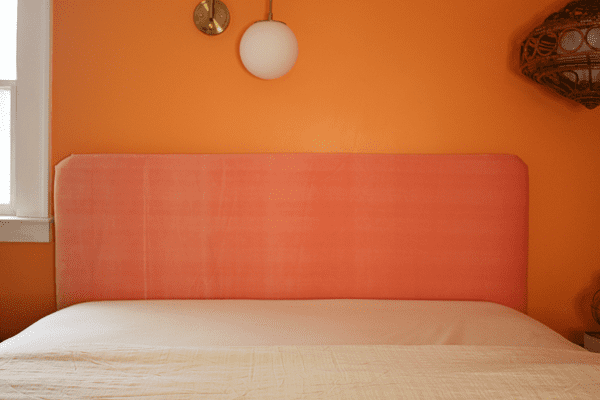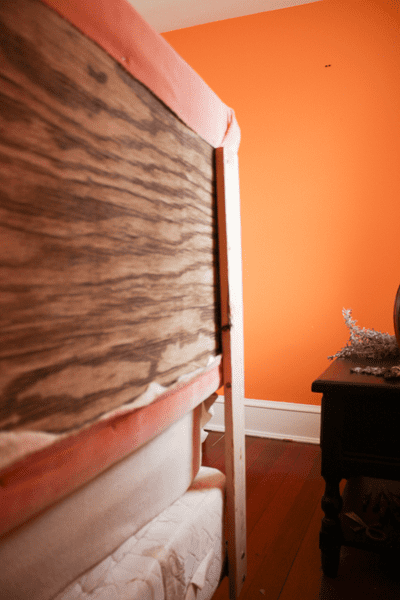When we first moved into our house we slapped some paint on the walls of the guest bedroom, added a bed and called it a day. And unless somebody was staying over night, I never really thought about it. But, if you follow my social media feeds, you know I’ve been paying it a little more attention and it’s slowly turning into a room I love.
My most recent addition is a headboard. I imagined a deep pink headboard against the vibrant orange walls but the fabric I had was a touch too purple and the store didn’t have what I was looking for. Unfortunately, when it comes to these kinds of projects, I’m not planner, I like to do a project RIGHT when I’m inspired. Luckily the fabric store had a pretty peach velvet fabric that I thought would look beautiful against the orange. And I was right, the orange walls, peach headboard and pink throw pillows remind me of a summer sunset. And, living in New England, I need summer wherever I can get it.



This was my first time making a headboard, so I went with something simple and was able to complete it in just a couple of hours. If you’ve been thinking about making a headboard, I encourage you to do it! Below is the process I followed.
(some of the links below are affiliate links, which means I may be compensated if you buy something)
Materials:
- Tape measure
- Masking tape or painters tape
- Plywood (I used a .5″ thick piece)
- T-square ruler (if you’re cutting the plywood yourself)
- Circular saw (if you’re cutting the plywood yourself)
- Upholstery foam (thickness based on preference- I used 2″ but could have gone thicker)
- Box cutter razor blade
- Batting (I used cotton)
- Upholstery fabric of choice (I used peach velvet that is now out of stock)
- Fabric scissors
- Staple gun (I LOVE this electric staple gun)
- Staples (I used 3/8″ staples)
- Adhesive (to attach upholstery foam to plywood)
Step 1: Plan the size of your headboard
My guest bedroom is small and the ceilings are low, so I knew I didn’t want an overwhelming headboard. What I did want was one I could see when I used throw pillows but not so tall it would encroach on the sconce above the bed.
I measured the height of that spot from my baseboard, plotted out a line from one side of the bed to the other and went over it with some painters tape, to create an outline of the headboard. The width of a queen size bed headboard is 62″.
I wanted the headboard to begin slightly below the mattress (to ensure there wouldn’t be a gap between the bed and the headboard) so I measured from slightly below the mattress to the painters tape and got the height of my headboard, which was 22″.
Step 2: Cut your plywood
If you’re buying your plywood especially for this project, ask the lumber store to cut it to size for you. If you’re like me and you’re using a piece of plywood you already have at home, do the following:
- Use your t-square ruler to measure out and mark the dimensions of your headboard (in my case 62″x22″)- make sure you’re measuring from a straight edge.
- Use your circular saw to cut along the lines you’ve made- I propped my plywood on saw horses to do this
Step 3: Cut your upholstery foam and attach to the plywood
I cut my upholstery foam slightly bigger than my plywood, using a boxcutter razor blade. I cut it slightly larger because I didn’t want the sharp edges of the wood poking or showing through once the headboard was done.
Once it was cut to size, I used spray adhesive to attach the foam to the plywood. Unfortunately the spray adhesive wasn’t strong enough and the foam detached from the wood. I wouldn’t use spray adhesive again- I would use a heavier duty adhesive (maybe wood glue).
Step 4: Cut your batting and fabric
I cut my batting and fabric 10″ longer than the width and height of my plywood, so I would have ~5″ of extra fabric along each side of the headboard. This was perfect and gave me the right amount of fabric to work with as I pulled and tightened the batting and fabric around the plywood and foam. Batting and fabric were both cut to 72″x32″
Step 5: Attach your batting and fabric to the headboard
I laid my fabric face down on the floor, laid my batting on top of that and my headboard (foam side down) on top of the batting. Made sure there was an even amount of fabric and batting around each side of the headboard and began stapling.
I stapled the batting first, starting in the middle of a long side and stapling along that edge until I was about an inch from each corner. Then I moved to the other long side, pulling the batting taut and stapling in the same manner.
Once the long sides were done, I moved to the short sides, following the same technique.
To staple the corners I gathered the fabric and pleated it, so it looked almost like a rabbits ear. Then I stretched it taut, stapled it to the plywood and cut away the excess fabric.
I followed the same stapling technique for the velvet fabric. Make sure you pull the fabric as tightly as possible, keeping the fabric smooth between staples.
Step 6: Attach your headboard
This step is completely dependent upon what you’re working with. Some people like to attach the headboard directly to the wall but I had a basic metal bed frame and decided to use the holes along the back of that frame to attach wood supports. I used 1″x4″ pieces of wood, measured to go from the base of the metal bedframe to about three quarters up my headboard. Here’s what I did:
- Cut the 1″x4″s to length (this will depend upon your bed and the size of your headboard)
- Placed each piece of wood against the bedframe and used a pencil to draw where the holes were
- Used a drill to create 2 holes (drill bit was the size of the bolts I was using) on each piece of wood, where I had marked the holes from the bedframe
- Attached the 1″x4″s to the bedframe with bolts, washers and nuts
- Pre-drilled three holes on each 1″x4″, to make it easier to screw them to the headboard
- Aligned the headboard and screwed the 1″x4″s to the headboard, using the pre-drilled holes and wood screws- this part was tricky- trying to keep the headboard level and in the right spot while screwing in the 1″x4″s. Luckily I had Chris to help me, I couldn’t have done that alone.
This is what the back of the headboard looks like:


This project was easy and can literally be done in a couple of hours (maybe less if you have all your tools and materials ready to go). I would definitely do this again!
Do you have any tips or tricks for creating a custom headboard? Tell me in the comments!
XOXO
Veronica


I love the colors you choose! You have a real sense of style.